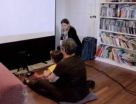(Press-News.org) University of Colorado Boulder Assistant Professor Nikolaus Correll likes to think in multiples. If one robot can accomplish a singular task, think how much more could be accomplished if you had hundreds of them.
Correll and his computer science research team, including research associate Dustin Reishus and professional research assistant Nick Farrow, have developed a basic robotic building block, which he hopes to reproduce in large quantities to develop increasingly complex systems.
Recently the team created a swarm of 20 robots, each the size of a pingpong ball, which they call "droplets." When the droplets swarm together, Correll said, they form a "liquid that thinks."
To accelerate the pace of innovation, he has created a lab where students can explore and develop new applications of robotics with basic, inexpensive tools.
Similar to the fictional "nanomorphs" depicted in the "Terminator" films, large swarms of intelligent robotic devices could be used for a range of tasks. Swarms of robots could be unleashed to contain an oil spill or to self-assemble into a piece of hardware after being launched separately into space, Correll said.
Correll plans to use the droplets to demonstrate self-assembly and swarm-intelligent behaviors such as pattern recognition, sensor-based motion and adaptive shape change. These behaviors could then be transferred to large swarms for water- or air-based tasks.
Correll hopes to create a design methodology for aggregating the droplets into more complex behaviors such as assembling parts of a large space telescope or an aircraft.
In the fall, Correll received the National Science Foundation's Faculty Early Career Development award known as "CAREER." In addition, he has received support from NSF's Early Concept Grants for Exploratory Research program, as well as NASA and the U.S. Air Force.
He also is continuing work on robotic garden technology he developed at the Massachusetts Institute of Technology in 2009. Correll has been working with Joseph Tanner in CU-Boulder's aerospace engineering sciences department to further develop the technology, involving autonomous sensors and robots that can tend gardens, in conjunction with a model of a long-term space habitat being built by students.
Correll says there is virtually no limit to what might be created through distributed intelligence systems.
"Every living organism is made from a swarm of collaborating cells," he said. "Perhaps some day, our swarms will colonize space where they will assemble habitats and lush gardens for future space explorers."
INFORMATION:
For a short video of Correll's team developing swarm droplets visit http://www.colorado.edu/news/multimedia/researchers-creating-team-tiny-robots. For more information about CU-Boulder's computer science department visit http://www.colorado.edu/engineering/academics/degree/computer-science.
END
Two new studies published in Psychological Science, a journal of the Association for Psychological Science, explore the development of reasoning and perspective-taking in children.
How to Pass the False-Belief Task Before Your Fourth Birthday
As social creatures, humans must constantly monitor each other's intentions, beliefs, desires, and other mental states. A particularly important social skill is the ability to take another person's perspective and understand what the person knows, even when that knowledge may ultimately be false. Past research has shown that before ...
BOSTON (December 14, 2012) –Scientists at the Jean Mayer USDA Human Nutrition Research Center on Aging (HNRCA) at Tufts University have discovered a new gene mechanism that appears to regulate triglyceride levels. This pathway may protect carriers of a gene variant against cardiovascular disease, especially among those with greater intakes of polyunsaturated fat (PUFA). The findings, published online this week in the American Journal of Human Genetics, contribute to research efforts to develop gene-specific diets that could potentially improve general health and complement ...
Tampa, FL (Dec. 14, 2012)— A new study focusing on how people with dementia become lost while driving, how missing drivers are found, and the role of public notification systems like Silver Alert in these discoveries suggests techniques that may help recover drivers with dementia and prevent potentially harmful incidents.
The study was led by principal investigator Meredeth A. Rowe, RN, PhD, FGSA, FAAN, professor and endowed chair at the University of South Florida College of Nursing. The findings were published online last month in the Journal of the American Geriatrics ...
Parents often wonder how much of the world their young children really understand. Though typically developing children are not able to speak or point to objects on command until they are between eighteen months and two years old, they do provide clues that they understand language as early as the age of one. These clues provide a point of measurement for psychologists interested in language comprehension of toddlers and young children with autism, as demonstrated in a new video-article published in JoVE (Journal of Visualized Experiments).
In the assessment, psychologists ...
(Santa Barbara, Calif.) –– While some theoretical physicists make predictions about astrophysics and the behavior of stars and galaxies, others work in the realm of the very small, which includes quantum physics. Such is the case at UC Santa Barbara, where theoretical physicists at the Kavli Institute for Theoretical Physics (KITP) cover the range of questions in physics.
Recently, theoretical physicists at KITP have made important strides in studying a concept in quantum physics called quantum entanglement, in which electron spins are entangled with each other. Using ...
At crucial points in the metabolism of all organisms, a protein with the unwieldy name of Translation Elongation Factor P (EF-P, for short) takes center stage. What it actually does during protein synthesis has only now been elucidated – by researchers at Ludwig-Maximilians-Universität in Munich.
The research group led by Kirsten Jung, Professor of Microbiology at LMU, actually focused on how bacteria cope with stress, for example how the receptor meolecule CadC monitors the acidity in the environment and alerts the cell to take countermeasures to protect itself. However, ...
This press release is available in German.
The mass ratio of protons and electrons is deemed to be a universal constant. And rightly so, as the latest radio-astronomy observations of a distant galaxy have shown. Scientists at the VU University of Amsterdam and the Max Planck Institute for Radio Astronomy in Bonn used the 100-metre radio telescope in Effelsberg to measure absorption lines of the methanol molecule at a number of characteristic frequencies. The researchers analysed the spectrum of the simplest of all the alcohols in a very distant galaxy. The result: to ...
The pelvic exam, a standard part of a woman's gynecologic checkup, frequently is performed for reasons that are medically unjustified, according to the authors of a UCSF study that may lay the groundwork for future changes to medical practice.
The research shows that many physicians mistakenly believe the exam is important in screening for ovarian cancer. The study, which surveyed obstetricians and gynecologists around the country, also shows that doctors continue to perform the exam in part because women have come to expect it.
The article is currently published online ...
Antibodies are key to the recognition and neutralisation of bacteria by our immune system. The most common antibodies have the shape of a Y, and the two prongs fasten to molecules that belong to the bacteria. The cells in the immune system recognise the shaft and can then attack the bacteria.
Since the 1960s, it has been known that certain bacteria have developed the ability to turn these antibodies around, which makes it more difficult for the immune system to identify them. These include streptococcus bacteria, sometimes referred to as 'killer bacteria', that cause ...
Memo to casino operators: just because you build it doesn't mean they will come.
A new study out of the University of Iowa examined how casino growth in the state has influenced gambling by residents. The survey suggests that fewer Iowans gambled overall and also that fewer people have become addicted to gambling despite a recent spurt in gaming facilities. Casino gambling was introduced in Iowa in 1991. There are currently 21 casinos in Iowa, all but three licensed by the state. (The others are owned and operated by Native American tribes.)
The findings could affect ...




